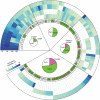Rapid microbial diversification of dissolved organic matter in oceanic surface waters leads to carbon sequestration
- PMID: 32747679
- PMCID: PMC7400608
- DOI: 10.1038/s41598-020-69930-y
Rapid microbial diversification of dissolved organic matter in oceanic surface waters leads to carbon sequestration
Abstract
The pool of dissolved organic matter (DOM) in the deep ocean represents one of the largest carbon sinks on the planet. In recent years, studies have shown that most of this pool is recalcitrant, because individual compounds are present at low concentrations and because certain compounds seem resistant to microbial degradation. The formation of the diverse and recalcitrant deep ocean DOM pool has been attributed to repeated and successive processing of DOM by microorganisms over time scales of weeks to years. Little is known however, about the transformation and cycling that labile DOM undergoes in the first hours upon its release from phytoplankton. Here we provide direct experimental evidence showing that within hours of labile DOM release, its breakdown and recombination with ambient DOM leads to the formation of a diverse array of new molecules in oligotrophic North Atlantic surface waters. Furthermore, our results reveal a preferential breakdown of N and P containing molecules versus those containing only carbon. Hence, we show the preferential breakdown and molecular diversification are the crucial first steps in the eventual formation of carbon rich DOM that is resistant to microbial remineralization.
Conflict of interest statement
The authors declare no competing interests.
Figures


References
-
- Hansell DA, Carlson CA, Repeta DJ, Schlitzer R. Dissolved organic matter in the ocean: a controversy stimulates new insights. Oceanography. 2009;22:202–211.
-
- Hansell DA, Carlson CA. Biogeochemistry of Marine Dissolved Organic Matter. Cambridge: Academic Press; 2014.
-
- Pomeroy LR, Williams PJL, Azam F, Hobbie JE. The microbial loop. Oceanography. 2007;20:28–33.
-
- Jiao N, et al. Microbial production of recalcitrant dissolved organic matter: long-term carbon storage in the global ocean. Nat. Rev. Microbiol. 2010;8:593. - PubMed
-
- Arrieta JM, et al. Dilution limits dissolved organic carbon utilization in the deep ocean. Science. 2015;348:331–333. - PubMed
Publication types
LinkOut - more resources
Full Text Sources

